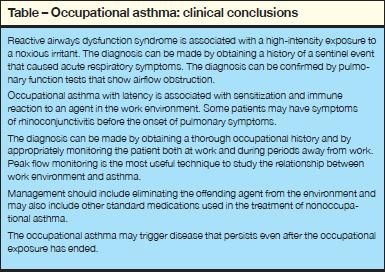- Clinical Technology
- Adult Immunization
- Hepatology
- Pediatric Immunization
- Screening
- Psychiatry
- Allergy
- Women's Health
- Cardiology
- Pediatrics
- Dermatology
- Endocrinology
- Pain Management
- Gastroenterology
- Infectious Disease
- Obesity Medicine
- Rheumatology
- Nephrology
- Neurology
- Pulmonology
Occupational asthma: Tips on establishing the diagnosis
When encountering a patient who may have occupational asthma, what is your approach to the initial evaluation? What are the most useful questions to ask?
When encountering a patient who may have occupational asthma, what is your approach to the initial evaluation? What are the most useful questions to ask?
Occupational asthma is an important form of adult-onset asthma and may lead to severe, difficult-to-control respiratory disease. The 2 main forms of occupational asthma are reactive airways dysfunction syndrome, which is associated with a high-intensity exposure to a noxious irritant, and occupational asthma with latency, which is associated with sensitization and immune reaction to an agent in the work environment. Determining whether occupational asthma is causing respiratory symptoms requires a high index of suspicion and a detailed occupational history (Table).

The diagnosis of reactive airways dysfunction syndrome can be made by obtaining a history of a sentinel event that caused acute respiratory symptoms, such as may occur in firefighters or after exposure to toxic fumes. The diagnosis can be confirmed by pulmonary function tests that show airflow obstruction.
Occupational asthma with latency may be more difficult to identify. Patients with this type of occupational asthma may report symptoms of rhinoconjunctivitis at work before the onset of pulmonary symptoms. It is crucial to accurately obtain a comprehensive work history and to establish the relationship between symptoms and the work environment.
Some patients may not experience symptoms until they have left work. It is important to ask about symptoms during prolonged periods away from work, since it may take a few days for the symptoms to abate. Typical exposures that may cause occupational asthma with latency include high molecular weight organic antigens (such as those causing baker's asthma) and low molecular weight agents (such as toluene diisocyanate, which painters are exposed to).
Confirming the diagnosis of occupational asthma with latency is not straightforward. The gold standard for diagnosis is the demonstration of an asthmatic response to an inhalation challenge; however, only a few specialized centers are able to do this. The development of a specific allergic response to an organic agent, or specific IgE testing, may provide circumstantial evidence to support a diagnosis of occupational asthma.
In practice, peak flow monitoring is the most useful technique to study the relationship between work environment and asthma. Patients' peak flow should be measured at work and during prolonged periods (at least 2 weeks) away from work. Patients should be instructed to record their peak flows 4 times a day.
Management of occupational asthma ideally should include eliminating the patient's exposure to the causative agent; clearly, this can have profound social and economic consequences. Pharmacological management includes rescue and controller therapy as is used for other forms of asthma. Remember that the disease might persist even after removal of the offending agent from the environment; in this case, the occupational exposure has triggered an asthma syndrome identical to that seen in patients without the environmental exposure.
